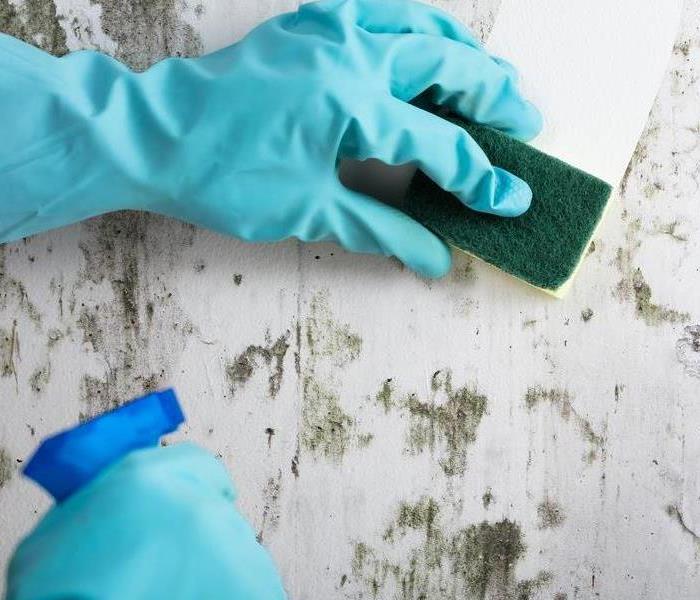Recent Mold Remediation Posts
Mold in Your Home? Recognizing Signs and Taking Action
12/8/2023 (Permalink)
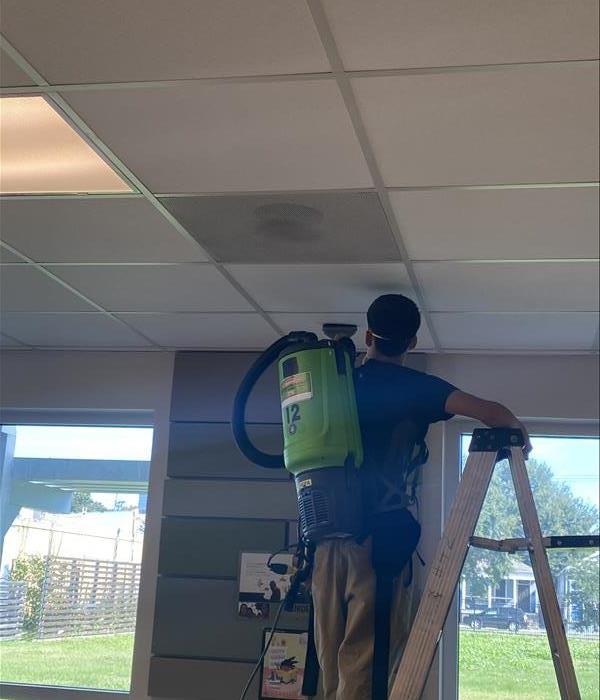 SERVPRO crew cleaning
SERVPRO crew cleaning
Mold can be a silent intruder, quietly spreading and causing harm to your home and health. Recognizing the signs of mold growth is essential to protect your property and loved ones. In this blog post, SERVPRO® discusses how to identify signs of mold in your home and what steps to take if you suspect its presence.
Recognizing Signs of Mold:
1. Musty Odor:
- One of the most common signs of mold is a musty, earthy smell in your home. If you notice a persistent, unexplained odor, it could indicate hidden mold growth.
2. Visible Mold Growth:
- Mold often appears as fuzzy, discolored patches on walls, ceilings, or other surfaces. It can range in color from green and black to white and orange.
3. Discoloration and Stains:
- Water stains or discoloration on walls, ceilings, or floors can be a sign of a moisture problem that may lead to mold growth.
4. Allergy Symptoms:
- Mold spores can trigger allergic reactions in some individuals. If you or your family members experience unexplained allergy symptoms such as sneezing, coughing, congestion, or skin rashes, mold may be the culprit.
5. Water Leaks or Damage:
- Previous water leaks or damage, even if they were repaired, can create ideal conditions for mold growth. Inspect areas where water damage has occurred in the past.
6. High Humidity Levels:
- Mold thrives in damp environments. If your home has consistently high humidity levels, it may be conducive to mold growth.
Steps to Take If You Suspect Mold:
1. Do Not Disturb the Mold:
- Mold spores can become airborne when disturbed. Avoid touching or attempting to clean the mold without proper protective equipment.
2. Isolate the Area:
- If you've identified a moldy area, seal it off to prevent the mold from spreading further. Close doors and cover vents if possible.
3. Contact SERVPRO:
- Reach out to SERVPRO for professional mold inspection and remediation. Our experts have the knowledge and equipment to safely assess and address mold issues.
4. Stay Out of Contaminated Areas:
- Until the mold is professionally removed, it's essential to avoid the affected area to minimize exposure to mold spores.
5. Address the Source:
- Identify and address the source of moisture that contributed to the mold growth. Whether it's a leaky roof, plumbing issue, or high humidity, addressing the cause is crucial to preventing future mold problems.
6. Follow Professional Recommendations:
- Rely on SERVPRO's expertise to guide you through the mold remediation process. Our technicians will develop a comprehensive plan to safely remove the mold and prevent its return.
Conclusion:
Mold can be a hidden threat to your home and health. Recognizing the signs of mold and taking swift action when you suspect its presence are essential steps to protect your property and loved ones. If you suspect mold in your home, do not hesitate to contact SERVPRO for professional mold inspection and remediation services. We're here to help you restore a clean and healthy living environment.
Ensuring Safety and Precision: SERVPRO's Mold Remediation in Orlando, FL
11/11/2023 (Permalink)
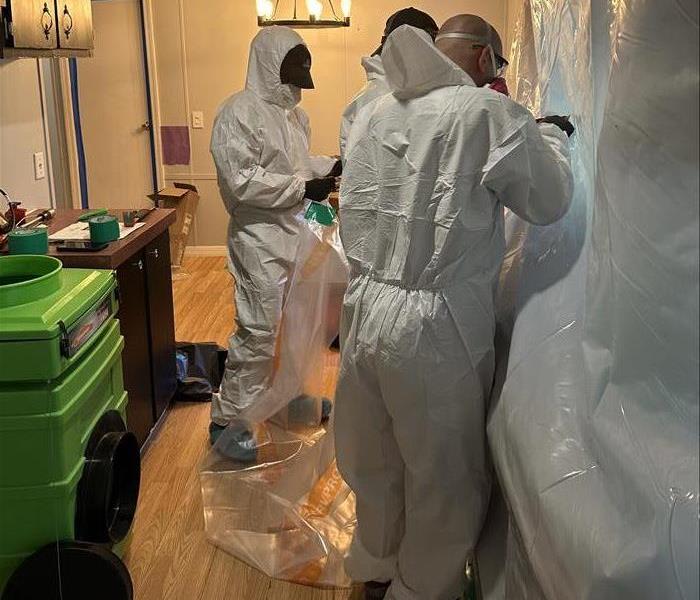 SERVPRO team on a mold remediation job
SERVPRO team on a mold remediation job
In the enchanting city of Orlando, Florida, where the magic of sunshine and humidity dances, the potential for mold growth is an ever-present concern. Safeguarding our homes and businesses requires a meticulous approach, and at SERVPRO, we're not just addressing mold; we're doing so with the utmost focus on safety. Let's dive into the unique Personal Protective Equipment (PPE) and cutting-edge tools our expert team deploys for mold remediation specifically tailored to the Orlando area.
Navigating the Orlando Mold Challenge:
- Orlando's magical atmosphere, coupled with its subtropical climate, creates conditions conducive to mold growth. As residents of this captivating city, we understand the need for a mold remediation process designed to suit Orlando's distinctive environment.
The SERVPRO Mold Remediation Arsenal:
1. Personal Protective Equipment (PPE):
- Safety takes precedence, starting with our technicians' attire. In Orlando, where mold spores can pose health risks, our team utilizes specialized PPE, including:
- Respirators: Safeguarding against the inhalation of mold spores.
- Protective Suits: Full-body protection to prevent skin contact with contaminants.
- Gloves and Eye Protection: Heavy-duty gloves and eye shields ensure safety during remediation.
2. Containment Barriers:
- To contain the mold and prevent its spread, we establish robust barriers. This containment is essential for protecting both our team and your Orlando property from cross-contamination.
3. Air Filtration Devices:
- SERVPRO employs advanced air filtration equipment, including HEPA filters. This technology captures microscopic mold spores from the air, ensuring a safer environment during and after remediation, specifically adapted to the needs of Orlando properties.
4. Specialized Cleaning Products:
- Orlando's unique environment demands tailored solutions. Our arsenal includes EPA-registered antimicrobial and antifungal cleaning agents. These products not only eliminate existing mold but also inhibit future growth, addressing the specific challenges faced by Orlando properties.
5. Moisture Detection Tools:
- In Orlando's subtropical climate, addressing the source of moisture is critical for effective mold remediation. Our technicians use state-of-the-art moisture detection tools to identify and eliminate hidden water sources contributing to mold growth.
6. High-Efficiency Particulate Air (HEPA) Vacuums:
- To capture and remove mold spores, our team employs HEPA vacuums. Designed to trap particles as small as 0.3 microns, these vacuums ensure thorough cleaning during the remediation process, tailored to the unique conditions of Orlando.
7. Thorough Documentation:
- In Orlando, transparency and accountability matter. SERVPRO provides detailed records of the entire procedure, offering peace of mind and valuable documentation for insurance claims or property transactions.
Why Choose SERVPRO in Orlando:
- Orlando is not just a location; it's a vibrant community we call home. When you choose SERVPRO for mold remediation in Orlando, you're choosing a team that understands the unique challenges of our city. Our commitment to safety, expertise, and utilizing the right equipment makes us your trusted partner in mold remediation.
Contact SERVPRO in Orlando Today:
- If you're grappling with mold issues in your Orlando home or business, prioritize safety. Contact SERVPRO of Orlando for a comprehensive mold remediation process crafted to ensure the well-being of your property and our enchanting community. Let's work together to keep Orlando homes and businesses safe, healthy, and truly magical.
Surplus of Summer Rain Can Lead to Mold in Your Orlando Home
8/7/2023 (Permalink)
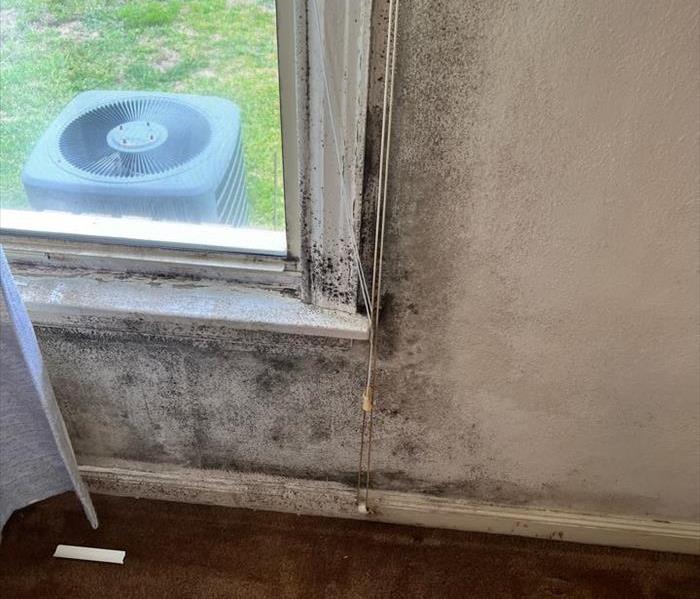 SERVPRO technicians called into assess mold outbreak after months of excessive summer rains.
SERVPRO technicians called into assess mold outbreak after months of excessive summer rains.
Mold can be lurking in hard to notice places. If you have a mold issue, SERVPRO will find it and resolve it.
We continue to have a lot of rain, with no end in sight! We hope all of you are doing well despite all of this water. This is great for our lawns and for helping recover from our recent drought, but water is one of Mother Nature's most destructive forces!
While you may not see any signs of water damage at your home or office, you may still have water or mold issues that you cannot see. Often times, mold and water damage can be hidden in places that are hard to see.
For example, a roof leak may only show a few drops on your ceiling, but it is actually spreading water around your attic or causing mold on your roof trusses. A little bit of water that seeps under the garage door can seem like no big deal, but the water has actually gotten into the walls, soaked into the sheet rock, and/or damaged your baseboards.
These and other water related issues can lead to mold. Sometimes you can see it, and sometimes you can't. Either way, it is still a problem that needs to be dealt with.
If you, your co-workers or loved ones start having headaches, stuffed/runny noses or symptoms that feel like allergies but you haven't had allergies in the past then you may have water or mold issues.
The professionals at SERVPRO are thoroughly trained on mold remediation and removal. We use state-of-the-art methods and machinery that is environmentally friendly and pet safe. Regardless of the type of mold you encounter or the size of your mold problem, our team will handle it quickly and effectively.
Remember, our team of mold remediation professionals is available 24/7 365 to help. Why not get some piece of mind and let our team do a free visual mold inspection at your home or office?
Call today and get the peace of mind you deserve.
Top Mistakes To Avoid When Cleaning Mold and Mildew
10/1/2018 (Permalink)
Proud homeowners who find that they have a mold problem on their hands might be gung-ho about getting rid of the problem on a Do It Yourself (DIY) basis, primarily to save cost. If you happen to fall under this category, do take note that other homeowners in the past who felt the same way have gone through the motions and made the following mistakes to avoid when it comes to removing mold around the home.
Gotta Catch Them All! One of the most common mistakes in cleaning up mold is figuring out that you have gotten rid of the problem for good. After all, for visible mold that you have just wiped clean with a tea tree oil solution, there is probably more from where it came from which remains hidden from your view. After all, mold spores are very small and extremely light in its makeup. This makes it very easy to spread from one particular area of the home to another. A single patch of mold growing in one area of the home is enough signal to perform a thorough inspection of the rest of the house in order to make sure that not a single nook and cranny remains unlooked at.
Bleach is Not the Answer Most people think that bleach, with its cleaning power, is able to do wonders when it comes to getting rid of mold. While bleach is rather effective when it comes to killing and removing mold from hard and non-porous surfaces, it does not get to the root of the problem. In order to make a bleach solution more effective, you should perform a mop up operation using an antimicrobial cleanser.
My Clothes Were Damaged By Mold in a Rarely Used Closet…Can We Save Them? Mold Remediation Approved
10/1/2018 (Permalink)
Those of us who live in Central Florida and surrounding areas like Winter Garden, Windermere, Apopka, and Lake Buena Vista know that moisture in our homes is a common issue. We try to maintain a temperature with our AC units that we can live with, that our power bill can sustain (and therefore our pocket), and that will keep that moisture down. We might find some mildew from time to time and take care of it ourselves. Or perhaps you’ve had a mold issue and have called in a professional company to take care of it for you.
What about those closets that we don’t open often? Perhaps you open the closet door looking for those golf clubs that you are finally getting around to using. Or maybe you finally have an opportunity to wear that dress that you got on clearance. Unfortunately as soon as you open the door you notice that everything in the closet seems to be discolored. Upon closer inspection you notice that it smells musty and looks like it might be mold. What can you do?
On its web site, IICRC.org, the Institute of Inspection, Cleaning, Restoration, and Certification states the following:
Foremost, any garment or fabric that has not suffered physical deterioration or discoloration as a result of mold growing on it, and that is washable (typically, a minimum of 130ºF for at least 10 minutes), can be restored completely. That goes for bacterial contamination as well, as evidenced by hospitals daily as they wash linens, gowns, surgical drapes, etc.
Dry cleaning also does a good job when evaluated and cleaned - often twice - by a qualified professional. Again, this assumes no deterioration or discoloration of the garment. Ultimately, sampling and evaluation by a qualified environmental professional can be used to confirm remediation of the garment.
Our team of certified professionals here at SERVPRO are available to help you with this process anytime. Please give us a call and we would be happy to walk you through the process.
Lot's of Rain Can Lead to Mold
10/1/2018 (Permalink)
 Mold can be lurking in hard to notice places. If you have a mold issue, SERVPRO will find it and resolve it.
Mold can be lurking in hard to notice places. If you have a mold issue, SERVPRO will find it and resolve it.
We continue to have a lot of rain, with no end in sight! We hope all of you are doing well despite all of this water. This is great for our lawns and for helping recover from our recent drought, but water is one of Mother Nature's most destructive forces!
While you may not see any signs of water damage at your home or office, you may still have water or mold issues that you cannot see. Often times, mold and water damage can be hidden in places that are hard to see.
For example, a roof leak may only show a few drops on your ceiling, but it is actually spreading water around your attic or causing mold on your roof trusses. A little bit of water that seeps under the garage door can seem like no big deal, but the water has actually gotten into the walls, soaked into the sheet rock, and/or damaged your baseboards.
These and other water related issues can lead to mold. Sometimes you can see it, and sometimes you can't. Either way, it is still a problem that needs to be dealt with.
If you, your co-workers or loved ones start having headaches, stuffed/runny noses or symptoms that feel like allergies but you haven't had allergies in the past then you may have water or mold issues.
The professionals at SERVPRO are thoroughly trained on mold remediation and removal. We use state-of-the-art methods and machinery that is environmentally friendly and pet safe. Regardless of the type of mold you encounter or the size of your mold problem, our team will handle it quickly and effectively.
Remember, our team of mold remediation professionals is available 24/7 365 to help. Why not get some piece of mind and let our team do a free visual mold inspection at your home or office?
Call today and get the peace of mind you deserve.
Mold is Everywhere, Even in the Cleanest Home or Office
10/1/2018 (Permalink)
 Got Mold? You may not be sure, but our team of professionals will be! Call SERVPRO for a free visual mold inspection today!
Got Mold? You may not be sure, but our team of professionals will be! Call SERVPRO for a free visual mold inspection today!
It's that time of year, when it rains everyday! Sometimes it is just passing showers and sometimes it is a tropical storm or hurricane! There is still plenty of nice weather to enjoy, but as is typical in Central Florida, there will be quite a bit of rain mixed in!
All that rain can lead to mold. Remember, mold needs moisture to grow and as long as that moisture is present mold will continue to grow. That's why it is important to stop any water or mold you find as quickly as possible, before it spreads.
We often hear from customers that they did not think they had mold in their home of office since they keep their property clean. While we highly recommend keeping your home or office clean, even the cleanest home or office can have a mold problem.
There are over 100,000 types of mold, most of which are harmless. These mold spores are in the air, love humidity and water and are able to grow quite well in our local environment. No matter how mush cleaning you do, mold is always around, and it is usually harmless.
So, how do you tell if you have a mold issue and if the mold you see is harmless? Simple, call the team at SERVPRO and let our trained professionals stop by and give you a free visual mold inspection? It is a quick, easy, and FREE service that can help detect any issues you may have.
You may not have anything to worry about, and we hope you don't, but wouldn't it be nice to know?
Does Your West Orange Home Have A Mold Problem?
8/29/2018 (Permalink)
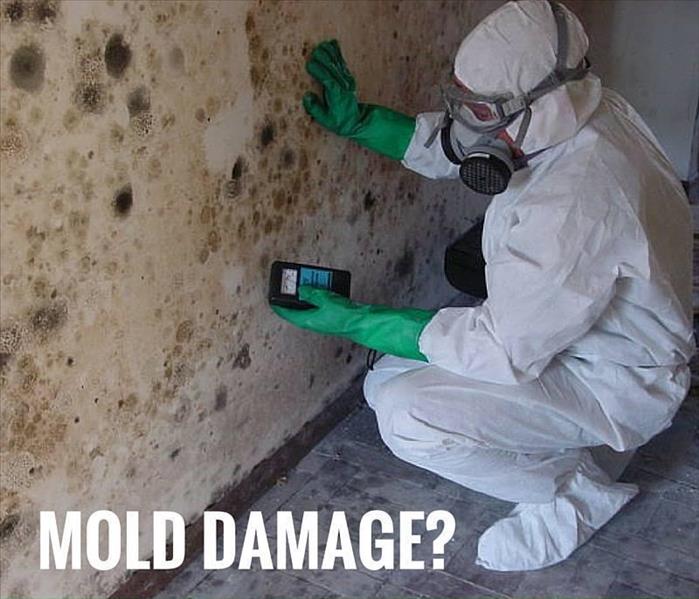 In Central Florida, mold can spread through a home in as little as 48 hours.
In Central Florida, mold can spread through a home in as little as 48 hours.
Microscopic mold spores naturally occur almost everywhere, both outdoors and indoors. This makes it impossible to remove all mold from a home or business. Therefore, mold remediation reduces the mold spore count back to its natural or baseline level. Some restoration businesses advertise “mold removal” and even guarantee to remove all mold, which is a fallacy. Consider the following mold facts:
- Mold is present almost everywhere, indoors and outdoors.
- Mold spores are microscopic and float along in the air and may enter your home through windows, doors, or AC/heating systems or even hitch a ride indoors on your clothing or a pet.
- Mold spores thrive on moisture. Mold spores can quickly grow into colonies when exposed to water. These colonies may produce allergens and irritants.
- Before mold remediation can begin, any sources of water or moisture must be addressed. Otherwise, the mold may return.
- Mold often produces a strong, musty odor and can lead you to possible mold problem areas.
- Even higher-than-normal indoor humidity can support mold growth. Keep indoor humidity below 45 percent.
Any Home Can Have A Mold Problem
5/2/2018 (Permalink)
Mold is a pervasive problem. Over the years after looking at thousands of properties of various shapes, sizes, quality of construction and inherent problems, you would think that I would have found that better, and much more expensive, built homes would have an advantage when it comes to water intrusion and mold consequences.
The truth is that generally that is not the case, and more frustratingly for the Homeowner of these homes, many times the damages are much more expensive. In this blog I give as an example a very expensive home in an exclusive neighborhood in Windermere, FL that we were recently involved with. In this particular case, because of the high quality finishing materials being used in a Master Bathroom (granite & marble), the source of the water was well hidden (shower pan) as well as the extent of the damage.
As you can see the Bathroom had no signs that there was a problem until the Homeowner finally noticed a couple of wood planks on the floor cupping. Even this visual damage to the planks was delayed because the wood floor had been installed over a plywood subfloor and moisture barrier over the concrete slab. Again, very well done construction and installation. SERVPRO went out to take moisture readings with a hammer probe of the wood flooring, and more importantly, the plywood subfloor underneath it.
This revealed that unfortunately the water had travelled much further under the plywood flooring than originally thought (wet plywood = mold). SERVPRO went ahead and presented a mold remediation estimate for the client based upon the few visible clues we had along with the moisture meters available. The problem the Homeowner and the Insurance Company had was that all the granite & marble was matching as well so there was an initial hope that this could be saved. Unfortunately, this was not the case. The water, mold and demo that needed to eventually occur ended up being very extensive.
While this was horrifying to the Homeowner, the other added unexpected surprise was signs of extensive termite damage. This was all found in the wood studs supporting the shower walls (behind drywall and granite). This termite damage had compromised the structural integrity of the extremely heavy granite supporting walls and a light soffit area above it. If this had not been found in a timely fashion, the possibility of structural collapse was possible.
Fortunately for the Homeowner, all of this damage was taken care of by Homeowner’s Insurance. I need to remind you however, that this Bathroom was immaculate and well-constructed. This water intrusion, mold and termite infestation and damage had probably been going on for years. The only clue that this was happening was a couple of small wood planks near the shower that was cupping (maybe 6-8 square inches). It would have been easy for the Homeowner to just write-off this cupping as just water coming off of their feet when exiting the shower. Most people would.
For those people that are reading this, who just happen to own Homes that would fit into the multi-million dollar mansion category, it is important to look at the small clues whenever possible. It is the nature of the expensive floor and wall coverings to be multi-layered and therefore makes it hard to find a problem that would normally be inexpensive to resolve if found quickly. There is no solution I offer to you in these types of situations except to always be wary and observant in your homes in any place where there is regularly running water and drains (Kitchens, Bathrooms, Utility Rooms, etc.).
*Photos for this Job are located in the Before and After section
Mold Remediation Steps
5/2/2018 (Permalink)
Have you ever wondered what happens when a mold removal specialist gets called to a mold-damaged facility?
Here are five steps that a mold removal specialist takes when conducting mold remediation:
1. Determine the degree of contamination. To do so, a mold remediation specialist may need to bring in an Indoor Environmental Professional (IEP) to determine the extent of the mold damage and test for contamination within the facility. Because mold spores and other microscopic contaminants can travel easily throughout a building, the IEP may collect and analyze samples from affected and unaffected areas of the building. Once the IEP has finished the inspection, they will develop a remediation plan for the mold removal specialist with steps to return the home to its preloss condition.
2. Set up and verify containment. To make sure mold contamination does not spread to other areas of a facility, the mold remediation specialist will set up containment by creating isolation barriers. Once the barriers are established, the specialist will verify containment with a lower partial pressure differential (negative pressure) to ensure there is no air leakage between containment zones. Exit chambers are used to serve as a transition between the containment and the unaffected area of the building. Once the containment is verified and the correct amount of pressure is achieved, the removal process can begin.
3. Remove unsalvageable materials. Porous materials and items that cannot be restored or cleaned effectively must be carefully discarded. Unsalvageable items include, but are not limited to, drywall, insulation and other items with visible mold growth. It is important for the specialist to wear the appropriate personal protective equipment which may include a full face respirator equipped with a P100/OV cartridge, disposable coveralls and nitrile gloves.
4. Clean surfaces with a high-attention to detail. A mold remediation specialist will likely begin the cleaning process by thoroughly vacuuming the contaminated areas using a HEPA vacuum with a high-efficiency filter to catch mold spores. He or she will then begin a detailed cleaning process involving mold removal tools such as a HEPA filtered sander, followed by the damp wiping of surfaces with an effective cleaning solution.
5. Verify remediation. Once cleaning is complete, the IEP will return to verify the remediation was successful. The area must be returned to the dry standard and should be visually dust free with no malodors. In addition, an IEP may perform surface or air sampling as part of the verification that the area is back to normal fungal ecology.
“Mold remediation requires mold removal specialists to perform techniques that promote source removal rather than relying on chemicals, paints and coatings as a replacement,” said Rachel Adams, President of Indoor Environmental Management, Inc. “Understanding and managing air flow is also critical to the success of a mold remediation project. Working with qualified IEP can also help to reduce the liability for the technician as well as provide a final determination if the remediation was successful.”
Steps Involved in Removing Mold
5/2/2018 (Permalink)
Have you ever wondered what happens when a mold removal specialist gets called to a mold-damaged facility?
Here are five steps that a mold removal specialist takes when conducting mold remediation:
1. Determine the degree of contamination. To do so, a mold remediation specialist may need to bring in an Indoor Environmental Professional (IEP) to determine the extent of the mold damage and test for contamination within the facility. Because mold spores and other microscopic contaminants can travel easily throughout a building, the IEP may collect and analyze samples from affected and unaffected areas of the building. Once the IEP has finished the inspection, they will develop a remediation plan for the mold removal specialist with steps to return the home and/or business to its preloss condition.
2. Set up and verify containment. To make sure mold contamination does not spread to other areas of a facility, the mold remediation specialist will set up containment by creating isolation barriers. Once the barriers are established, the specialist will verify containment with a lower partial pressure differential (negative pressure) to ensure there is no air leakage between containment zones. Exit chambers are used to serve as a transition between the containment and the unaffected area of the building. Once the containment is verified and the correct amount of pressure is achieved, the removal process can begin.
3. Remove unsalvageable materials. Porous materials and items that cannot be restored or cleaned effectively must be carefully discarded. Unsalvageable items include, but are not limited to, drywall, insulation and other items with visible mold growth. It is important for the specialist to wear the appropriate personal protective equipment which may include a full face respirator equipped with a P100/OV cartridge, disposable coveralls and nitrile gloves.
4. Clean surfaces with a high-attention to detail. A mold remediation specialist will likely begin the cleaning process by thoroughly vacuuming the contaminated areas using a HEPA vacuum with a high-efficiency filter to catch mold spores. He or she will then begin a detailed cleaning process involving mold removal tools such as a HEPA filtered sander, followed by the damp wiping of surfaces with an effective cleaning solution. 5. Verify remediation. Once cleaning is complete, the IEP will return to verify the remediation was successful. The area must be returned to the dry standard and should be visually dust free with no malodors. In addition, an IEP may perform surface or air sampling as part of the verification that the area is back to normal fungal ecology.
“Mold remediation requires mold removal specialists to perform techniques that promote source removal rather than relying on chemicals, paints and coatings as a replacement,” said Rachel Adams, President of Indoor Environmental Management, Inc. “Understanding and managing air flow is also critical to the success of a mold remediation project. Working with qualified IEP can also help to reduce the liability for the technician as well as provide a final determination if the remediation was successful.”
Central Florida, Did you know that August is Mold Awareness month?
7/17/2017 (Permalink)
These days it seems like there is an awareness month for just about anything. The month of August, for example celebrates this list of things also:
- Admit You’re Happy Month
- Family Fun Month
- National Catfish Month
- National Eye Exam Month
- National Golf Month
- Peach Month
- Romance Awareness Month
- Water Quality Month
- National Picnic Month
With all of these other things to celebrate or be aware of, why is mold awareness so important and who in the world thought it was important enough to need an entire month of attention each year?
Let’s start with “The Who”-The Responsible Solutions to Mold Coalition (RSMC) is responsible for declaring August Mold Awareness month each year. RSMC is a consortium of associations, companies, government and academic organizations dedicated to communicating accurate, science-based information on controlling mold. The group was launched at the International Builders’ Show in Orlando, FL in January of 2006.
“The Why”- “Our message is simple: if you control moisture, you’ll control mold,” said Frank Nunes, Vice Chairman of the organization and Executive Director of the International Institute for Lath and Plaster. “By declaring August ‘Mold Awareness Month,’ we want everyone with an interest in construction and remodeling to know that they can keep moisture out and therefore prevent the onset of mold primarily through attention to detail during the design, construction and remodeling process.”
The RSMC has a very informative web site, http://www.responsiblemoldsolutions.org. This web site is set up to so that you can access a residential or commercial building with an interactive model. By clicking on the model you can find relevant principles that will help you keep moisture out of that specific area.
For more detailed information on this topic, check out the full article about Mold Awareness Month and the RSMC at http://www.randrmagonline.com/articles/84551-responsible-solutions-to-mold-coalition-declares-august-mold-awareness-month






 24/7 Emergency Service
24/7 Emergency Service


